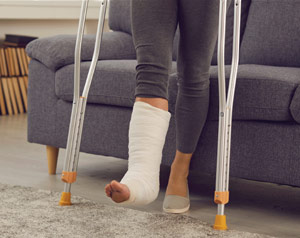 Throughout our lives, our body keeps our bones strong by replacing old bone cells with new bone cells, but as we age this process slows down and we gradually lose more bone than we make. When bone loss occurs more rapidly than normal, bones become thin and weak, a condition called osteoporosis. When bones are severely weakened, something as simple as a fall from standing height can lead to a cracked or broken bone (called a fragility fracture), which can cause disability and sometimes even lead to death.
Throughout our lives, our body keeps our bones strong by replacing old bone cells with new bone cells, but as we age this process slows down and we gradually lose more bone than we make. When bone loss occurs more rapidly than normal, bones become thin and weak, a condition called osteoporosis. When bones are severely weakened, something as simple as a fall from standing height can lead to a cracked or broken bone (called a fragility fracture), which can cause disability and sometimes even lead to death.
WHAT IS YOUR RISK?
To prevent osteoporosis and the consequences it can cause, it is important to understand what your risk of thinning bones is. This is analyzed in several ways. A bone mineral density (BMD) scan is a painless test performed at an imaging lab that measures the density of your bones. It can tell whether you have osteoporosis now or how likely you will be to develop it in the future. Doctors often combine the results of a BMD test with an assessment of your risk factors to provide a more accurate way of predicting your risk of a fracture.
There are two tools available to help doctors make this assessment. THE CAROC TEST considers your BMD test score along with your age, gender, fracture history, and steroid use to determine your risk of a fracture within the next ten years. THE FRAX TEST takes into account the same factors as the CAROC test, but it also looks at your BMI (weight-to-height ratio), if you have any health conditions that contribute to bone loss, if either of your parents had a hip fracture, if you are a smoker, and how much alcohol you consume. Because it includes many more risk factors than the CAROC test, the FRAX test can be used without a BMD score.
REDUCE YOUR RISK
Adopting certain healthy lifestyle habits can help prevent, delay, or reduce bone loss, which can offset the complications associated with osteoporosis.
Here are some helpful pointers:
EXERCISE: Regular physical activity that involves resistance training along with weightbearing aerobic exercise can help build and maintain bone strength. Exercises such as yoga and Tai Chi that focus on balance can help people who are at risk of falling.
CALCIUM: This mineral is essential for healthy bone development. Good sources include dairy products, calcium-fortified beverages, and legumes such as soybeans and chickpeas. If you don’t get enough calcium from your diet, calcium supplements might be a good choice for you and are available as liquid, chewable tablets, gummies, or regular tablets. Most adults require 1000mg to 1200mg of calcium per day. A cup (250mL) of milk, ice cream, or yogurt or 2 ounces (60g) of cheese contains about 300 mg of calcium.
VITAMIN D: The body needs vitamin D in order to absorb calcium, so it is important to make sure you get enough of it. Sun exposure can help our bodies naturally produce our own vitamin D, but in northern countries like Canada, adding vitamin D from food or supplements is often required to ensure we get enough. In Canada, cow’s milk and margarine must be fortified with vitamin D. It can also be found in some fortified beverages including milk-alternatives and some orange juices, fatty fish such as salmon, fish liver oils, and egg yolks. Adults 50 years and over require 800 IU to 2000 IU of vitamin D per day. Vitamin D supplements are available as concentrated drops, chewable or regular tablets, tablets that dissolve under your tongue, gummies, and liquids.
TREATING OSTEOPOROSIS
If you have a high risk of fracture, your doctor will probably recommend treating your osteoporosis with medication in addition to making healthy lifestyle choices. Medicines used to treat osteoporosis fall into two main categories that either slow down the removal of old bone cells or increase the formation of new bone cells. Some osteoporosis drugs are taken by mouth; others are injected under the skin or delivered by IV infusion into a vein. Your healthcare team, including your pharmacist, can discuss each medication and help you decide which treatment and prevention plan is best for you.

